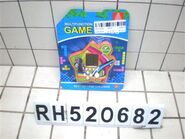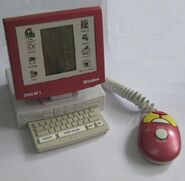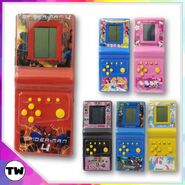
A relatively common version of a brick game unit, the POP station, designed to emulate the look of the PSP.
"Brick game" refers to an umbrella term for a commonly cloned hardware architecture and set of games. It is unknown who was responsible for creating the first "brick game" unit, nor who was responsible for developing the original game software. It is generally believed that the first of these systems begun popping up some time during the 1990s, and are still being manufactured to this day by various manufacturers. An unfinished emulator is currently in development, and is currently usable in Java. Several independent developers also created remakes of brick games on the Google Play Store for Android devices.
These systems come in just about any shape and size imaginable, as they are all built by several different manufacturers. Occasionally, a manufacturer will slightly alter the built-in memory to either add or remove games. Nonetheless, they are all ultimately built on the same engine, and as such, there are certain features that can determine if a system is considered to be a "brick game":
- A monochrome 10x20 LCD screen. The screen features two pink rubber pads which communicate with a line of contacts on some models.
- A single action button, with 4 directional buttons (In a similar fashion to an Atari 2600 joystick). In some variations, there are three directional buttons.
- When first booting up the system, you will be greeted with a message boasting “9999 in-1” as the speaker beeps a specific tune (most commonly a rendition of "Little Brown Jug"). The “9999 in-1” message will vary around "138 in-1" or "668 in-1" for example.
- Games you select are symbolized with letters, which occasionally appear to spin around a 3D axis.
- The game library consists of a large number of Tetris clones, each adding a different twist to the last game.
- Several other primitive games, which can vary depending on the system, such as a Breakout clone, Tanks, Snake, a generic top-down racing game, and more.
- A little animated character on the right side of the screen who waves their arms in response to the players gameplay.
- Crude sounds. Some systems can only beep, while others are capable of creating noise, but that’s generally all they’re capable of.
Games[]
As previously stated, the games on these systems can vary depending on the manufacturer. As such, it's hard to pin down every game ever made for these style of machines. As such, there may be some games absent from the following list. It is also worth noting that, because of the inherent technical limitations, none of these games have any real names (at least on the console. Names can be listed in instruction manuals (mostly imported brick game units), but are inconsistent).
- A basic clone of Tetris. The player must stack blocks in order to clear lines.
- Another extremely common game to find on these is one featuring several tanks, where the players goal is to shoot down as many enemy tanks as possible to obtain a high score. But with each level often feature "boss battle" in the end where the player would face off a large tank. Some versions omit the boss level and increases the level instantly after the target number has been achieved. The player's tank can easily be identified with a single block (sometimes flashing) on the back which the enemy tanks don't have. Some version does not distinguish between the player and enemy. If the player loses a life, the enemy counter is often reset.
- A driving game, in which the player attempts to pass as many cars as possible without crashing in order to obtain a high score.
- A clone of Snake in which the player tries to obtain the randomly placed "fruit" in the playfield without touching a wall or themselves. Rather then continually get longer like you would in Snake, however, the player stops growing after eating only 13 fruits, causing the snake to restart to beginning size, and creating another maze of obstacles. This in turn makes it more of a game of endurance rather then strategy.
- A clone of Breakout, in which the player controls a paddle trying to break through a layer of blocks on the top of the screen. Due to the limited resolution of the screen, however, it's made far easier to get the ball stuck in an endless loop. To fix this, move the paddle if the ball touches it and the ball will go to a different direction.
- A clone of Frogger, but with much of the variety and difficulty reduced.
- Another driving game, except this time the player attempts to guide the car through a narrow, winding road.
- A shooting game in which a random set of pixels constantly close in on you from the top of the screen, and you must stop them from reaching the bottom.
- A clone of Quarth, a shooting game where you have to fill in incomplete falling blocks.
- A Simon Says type game, where the player must select the correct direction key depending on what "Simon" says. This appears in some versions of the devices.
- A combination of both Breakout and the previous shooting games in which players shoot at a predefined block of pixels (which can shoot one of it's pixels at them) without getting shot by one of the blocks from the image.
- A soccer-like game, where you attempt to get your ball past the moving guard to the top side of the screen. This game is practically impossible to lose, however, as all you need to do to win is hold down the action button.
- A dice game. The player selects between "small number" (S), "large number" (L) or "three fives" and proceeds to roll three dices. An extra point is gained when the rolled number of dice corresponds correctly with the selected option.
- A scrolling shooter that appears to be a modified version of the car racing game. The player controls the car and shoot obstacles or enemies.
- A "dancing game", with scrolling notes representing the directional keys, where you must hit the directional key to score points, and the music and notes slowly goes faster.
Variations[]
There are two distinct versions of the system, the Russian variant and the Chinese/Asian variant, with the Chinese/Asian variant being the most common today. They are undoubtedly the same machine, and play all of the same games with the same menu system and screen. The only noticeable difference between the two is their batteries, with the Russian systems using three with loud sound, while the Chinese/Asian models uses only two with quieter sound. There is also a quite popular version of the brick game unit called the Pro 200, which also doubled as a calculator and was advertised on an infomercial in 1998, which infamously featured a scene of a Street Fighter II SNES cartridge being thrown into a garbage can in touting the system's cartridge-free operation.
It is possible to switch game variations in certain brick game units by holding the sound and reset buttons, and then continuously tapping the rotate button until the title screen appears, followed by releasing the buttons and then restarting the system. The narrow road variant of the racing game is notably only featured in one of the game sets as mentioned, with the game sets differing from unit to unit but stored in one unit for manufacturing purposes, ostensibly creating an illusion of multiple variations.
There is also a "electric shock" prank device in shape of the brick game, which as a practical joke toy does not have a PCB inside it. The device was featured in a video made by DiodeGoneWild.
The tune on the common brick games, “Little Brown Jug”, which was presumed to be the only time the song was featured was in said brick games, was also found on a common alarm clock that was sold on many shopping websites, the Moodicare Colour Change Alarm Clock.
Legality[]
Technically speaking, the majority of "brick game" software is arguably legal - in part due to how primitive the technology actually is. However, following the formation of The Tetris Company in 1996, brick games were often subject to legal disputes. Because of this, many brick game handhelds sold in the United States (somewhat ironically) remove all Tetris variants, while keeping the clones of other games (e.g. Breakout).
In late 2001, toy manufacturer Westminster Inc. was demanded to recall a "Pocket Arcade" range of brick games, presumably via The Tetris Company. A representative of Westminster contacted U.S. Customs about the dispute, arguing that the device "cloning" Tetris was merely a limitation of its actual hardware capabilities. While Customs understood this argument, it was concluded that the game was so close of a clone that it effectively qualified as piracy.[1] Later versions of the Pocket Arcade handhelds would remove the Tetris game.





























